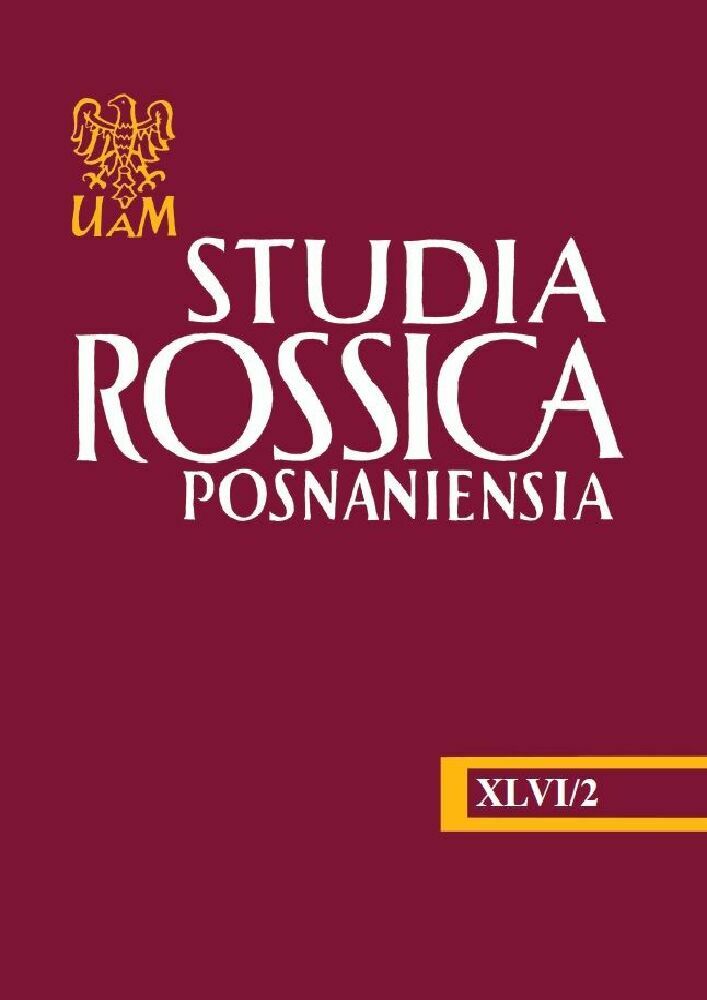Abstract
Basing on Aleksandr Medvedkin’s New Moscow and Ivan Pyryev’s The Swineherd and the Shepherd, this case study analyses the way the “new” Moscow was represented as a space of realised utopia in the Soviet socialist realist films of the 1930s and at the beginning of the 1940s. Functioning as a supranational centre of the Soviet “affirmative action empire” (Terry Martin), the cinematographic Moscow casts off all constraints of ‘Russianness’ in order to become a pan-Soviet model which, both in its architecture and semantics, could epitomize the perfect city and the perfect state. The comparative analysis of both films demonstrates that, although both directors show Moscow through the lens of the so-called “spaces of celebration” (Mikhail Ryklin), ‘their’ Soviet capital does not compensate for the “traumas of the early phases of enforced urbanization”, as Ryklin supposed. Rather, it operates as a transformation machine whose impact pertains only to periphery and can be effective once the representatives of this periphery have left Moscow. The complex inclusion and exclusion mechanisms resulting from this logic turn the idealised Soviet capital into a space which only the guests from peripheral regions can perceive as utopian. The ensuing suppression of
the inner perspectives on ‘utopian’ Moscow is interpreted here as a manifestation of the “cinematic
unconscious”, which accounts for the anxieties of the inhabitants of the capital concerning both Stalinist terror and their own hegemony in a society haunted by the purges.
References
Assmann, Aleida. Erinnerungsräume. Formen und Wandlungen des kulturellen Gedächtnisses. München, Beck, 1999.
Augé, Marc. Nicht-Orte. Übersetzt von Michael Bischof. München, Beck, 2011.
Bohn, Thomas M. Minsk – Musterstadt des Sozialismus. Stadtplanung und Urbanisierung in der Sowjetunion nach 1945. Köln, Böhlau, 2008.
Brockmann, Stephen. A Critical History of German Film. Rochester (NY), Camden House, 2010.
Bulgakow, Michail. Der Meister und Margarita. Übersetzt von Ralf Schröder. Berlin, Volk & Welt, 1995.
Bulgakowa, Oksana. „Symbolische Topographie des neuen Moskau im Film. Wie eine Stadt im Kopf entsteht“. Mastering Russian Spaces. Raum und Raumbewältigung als Probleme der russischen Geschichte. Hrsg. von Karl Schlögel unter Mitarbeit von Elisabeth Müller-Luckner. München, Oldenbourg, 2011, S. 253–278.
Chertenko, Alexander. „Možlyvo, mur buv metaforoju…“ Deščo pro istoriju odnieji fihury myslennja. Piznavaty kordony – perestupaty kordony – dolaty kordony. Hrsg. von Hans Richard Brittnacher, Ievgeniia Voloshchuk und Alexander Chertenko. Kyiv, Burago, 2011, S. 117–163.
Dobrenko, Evgenij. Politekonomija socrealizma. Moskau, Novoe literaturnoe obozrenie, 2007.
Dobrenko, Evgeniy. Stalinist Cinema and the Production of History: Museum of the Revolution. Edinburgh, Edinburgh University Press, 2008.
Drubek-Meyer, Natascha. „Primat des Doubles. Zwei sowjetische Filmkomödien: A. Medvedkins Novaja Moskva (1938) und G. Aleksandrovs Vesna (1947)“. Mystifikation, Autorschaft, Original. Hrsg. von Susi Frank, Renate Lachmann, Sylvia Sasse et al. Tübingen, Narr, 2001, S. 239–261.
Feuchtwanger, Lion. Moskau 1937. Ein Reisebericht für meine Freunde. Amsterdam, Querido, 1937.
Groys, Boris. Die Erfindung Rußlands. München, Hanser, 1995.
Groys, Boris. Gesamtkunstwerk Stalin. Die gespaltene Kultur in der Sowjetunion. München, Hanser, 1988.
Hartmann, Anne. „Thomas Morus in Moskau. Die Sowjetunion der 1930er Jahre als Utopia“. Das Wort. Germanistisches Jahrbuch Russland, 2007, S. 103–117.
Jakovleva, Galina. „Ot universalij k unifikacii. Gradostroitel’nye koncepcii 1920-h godov i perioda 1930-h – načala 1950-h godov“. Architektura SSSR, 3, 1990, S. 28–36.
Lenin, V[ladimir]. Polnoe sobranie sočinenij, Bd. 44. Moskau, Izdatel’stvo političeskoj literatury, 1970.
Ljusyj, Aleksandr. Moskovskij tekst. Tekstologičeskaja koncepcija russkoj kul’tury. Moskau, Veče, 2013.
Martin, Terry. The Affirmative Action Empire: Nations and Nationalism in the Soviet Union, 1923–1939. Ithaca–London, Cornell UP, 2001.
Neutatz, Dietmar. „«Schmiede der neuen Menschen» und Kostprobe des Sozialismus: Utopien des Moskauer Metrobaus“. Utopie und politische Herrschaft im Europe der Zwischenkriegszeit. Hrsg. von Wolfgang Hardtwig unter Mitarbeit von Philip Cassier. München, Oldenbourg, 2003, S. 41–56.
Papernyj, Vladimir. Kul’tura „dva“. Ann Arbor (MI), Ardis, 1985.
Revzin, Grigorij. „Moskva – fabrika utopij“. Kommersant, 49, 21.03.1998, S. 10. Web. 01.12.2020. https://www.kommersant.ru/doc/194958.
Ryklin, Michail. Räume des Jubels. Totalitarismus und Differenz: Essays. Übersetzt von Dirk Uffelmann. Frankfurt am Main, Suhrkamp, 2003.
Schlögel, Karl. „Utopie als Notstandsdenken – einige Überlegungen zur Diskussion über Utopie und Sowjetkommunismus“. Utopie und politische Herrschaft im Europe der Zwischenkriegszeit. Hrsg. von Wolfgang Hardtwig unter Mitarbeit von Philip Cassier. München, Oldenbourg, 2003, S. 77–96.
Schlögel, Karl. Terror und Traum. Moskau 1937. München, Hanser, 2008.
Shlapentokh, Dmitry, Vladimir Shlapentokh. Soviet Cinematography 1918–1991: Ideological Conflict and Social Reality. New York, De Gruyter, 1993.
Stites, Richard. Revolutionary Dreams: Utopian Vision and Experimental Life in the Russian Revolution. New York–Oxford, Oxford University Press, 1989.
Urussowa, Janina. Das neue Moskau. Die Stadt der Sowjets im Film 1917–1941. Köln, Böhlau, 2004.
Uspenskij, Boris. Poetik der Komposition. Struktur des künstlerischen Textes und Typologie der Kompositionsform. Übersetzt von Georg Mayer. Frankfurt am Main, Suhrkamp, 1975.
Vighi, Fabio. Traumatic Encounters in Italian Film: Locating the Cinematic Unconscious. Bristol (UK) Portland (OR), Intellect, 2006.
Voloshchuk, Ievgeniia. „Die «schöne neue Welt» des Sowjetimperiums in Joseph Roths Reportagenreihe «Reise in Rußland»“. Der lange Schatten des „Roten Oktober“. Zur Relevanz und
Rezeption sowjet-russischer Kunst, Kultur und Literatur in Österreich 1918–1938. Hrsg. von Primus-Heinz Kucher und Rebecca Unterberger. Berlin, Lang, 2019, S. 133–148. Widdis, Emma. Alexander Medvedkin. London–New York, I.B. Tauris, 2005.
License
THE ARTICLES ARE PUBLISHED UNDER THE CREATIVE COMMONS LICENCE:
Attribution-NonCommercial-ShareAlike 4.0 International License.
Authors of texts accepted for publication in “Studia Rossica Posnaniensia” are required to complete, sign and return to the editor's office the Agreement for granting a royalty-free license to works with a commitment to grant a Creative Commons sub-license.
Under the agreement, the authors of texts published in “Studia Rossica Posnaniensia” grant the Adam Mickiewicz University in Poznań a non-exclusive, royalty-free license and authorize the use of Attribution-NonCommercial-ShareAlike 4.0 International (CC BY-NC-SA 4.0).
The authors retain the right to continue the free disposal of the work.
Internet users are entitled to use works published in “Studia Rossica Posnaniensia” since 2016, for non-commercial purposes only, under the following conditions: https://creativecommons.org/licenses/by-nc-sa/4.0/
Adam Mickiewicz University in Poznań retains the right to magazines as a whole (layout, graphic form, title, cover design, logo etc.).

